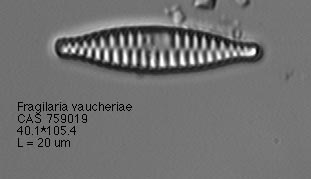
Fragilaria
Lyngbye Description
Frustules araphid,
symmetrical to apical and transapical axes, although some species are triradiate
rather than bipolar. Axial area distinct, central area expanded bilaterally,
unilaterally or absent. Genus distinguished from Synedra by specimens
forming short to extremely long ribbon-like colonies. Members of the genus are
sometimes difficult to recognize since their filamentous nature is not always
apparent in cleaned material.
Labiate process
and spines present, valves linear to elliptical, apices rostrate or capitate.
At valve center, the striae are often occluded, appearing as ghost structures.
Apical pore fields present.
The taxonomy of
this genus has been debated over the last several year, between "splitters"
(who recognized five additional genera in what have been classically recognized
as Fragilaria species, including Fragilariforma [Fragilaria
virescens and allies], Puncastriata [Fragilaria pinnata and
allies], Pseudostaurosira [Fragilaria bevistriata], Staurosira
[Fragilaria construens] and Staurosirella [Fragilaria lapponical],
and "lumpers" (e.g. Krammer and Lange-Bertalot 1991) who combine most Synedra
species as well as Opephora and Hannaea with Fragilaria.
We continue to follow the classical approach until more convincing evidence
is presented by either side of the argument.
Light Microscope
Image(s)

Each image is accompanied by the genus and species, California Academy of Sciences slide number (ie. CAS 612010), location of the specimen on the slide, and dimension in microns.